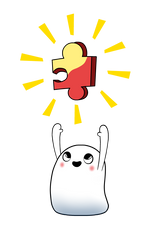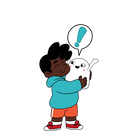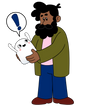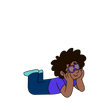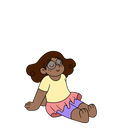
Snorble accelerates your child's development to create a tomorrow full of infinite possibilities.
Our smart companion grows with your child by combining the best in tech, education, and healthy habits (such as quality sleep) to give every child a chance to excel.
Watch how it works!
Get ahead of your child’s development with Snorble and prepare them for the future they will live in and help create.
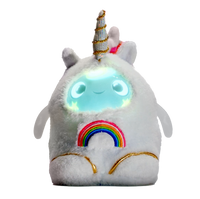
$299*
*Pre-order now with
no money down
Snorble Grows With Your Child
Newborns 0–3 months old
Coming Soon
Snorble grows with your child so you don’t have to buy additional systems as your child goes from newborn to infant. With soundscapes and ambient low lights, these sleep tools can help your kiddo get to sleep.
Infants 4–12 months old
Coming Soon
Snorble’s ability to grow as your kid grows helps them as they go from infancy to toddlerhood. With soundscapes, ambient lowlights, and an introduction to learning, set your little one up for success early.
Toddlers 1–2 years old
Snorble can help by ensuring your kiddo has the tools necessary to help them get to sleep and stay asleep. Plus, your youngster gets healthy habit-building tools to kickstart their social-emotional development and cognitive skills.
Preschoolers 3–5 years old
With Snorble’s Magical Bedtime Experience™ and wind-down activities, your child has everything they’ll need to catch some zzzs. They’ll also benefit from play-based learning games and mindfulness activities.
School-agers 6–8 years old
Coming Soon
For older children, Snorble has yoga, mindfulness, and other wind-down activities to keep them calm and jokes to build their sense of humor. We’ll also be rolling out more educational content for this age group in the future.
Coming Soon Products
The Snorble System
Our smart companion turns play-based learning on its head by using the best in tech and social-emotional development research as its core.
Our system is designed to grow with your child in a way that no other learning-driven platform can.

Snorble is an investment in your child’s future providing the basis for:
- Healthy habits
- Social-emotional development
- Educational advancement
Games and activities
Snorble’s games are entertaining and silly so you’ll love counting, singing, dancing, and playing.
Interactive STEAM games
To help your child learn foundational skills like counting, primary problem solving, and educational basics like colors.
Math is cool!
Learn to count and add and subtract.
The building blocks of math
From counting to addition, subtraction and problem-solving, you’re little one will impress you with their love of mathematics.
Cuddly and portable
Have you hugged your smart companion today? You can hug Snorble, cuddle with them and take them anywhere.
Portable
Take Snorble with you wherever you go.
Reading is fundamental
Have a blast with Snorble’s comprehension and language activities to build your vocabulary.
Reading, comprehension, and language aids
Our system helps children learn and understand how language works via interactive activities and animal games.
Relaxing is fun
Sometimes you need to wind down. Try yoga, meditation, and mindfulness to have a relaxing time before bed.
Relaxation and reflection activities
Our wind-down component, gives kids the opportunity to relax through yoga, meditation, and mindfulness exercises.
Storytime
Learn about the magical world of Lullaboo, where Snorble comes from, and let your imagination run wild.
Stories
Snorble can tell your child tales of magic and wonder in a way that encourages curiosity and imagination.
Celebrate your good job
Get cool (virtual) stars when you complete daily or nightly activities like brushing your teeth.
Reward system
From daily celebrations to graduating milestones, complete with fanfare music, and excitement, our Reward System allows you to praise your child at every turn.
Grow. Thrive. Excel.

Customizable
You control which features your child has access to through the Snorble app.
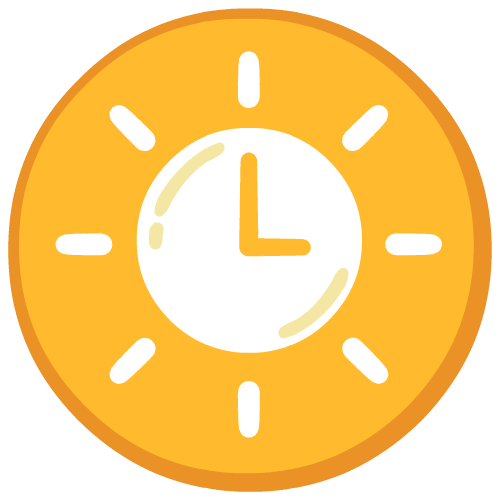
Day and night support
Snorble is here for your family day and night with pre-loaded games and activities to help your kiddo create meaningful experiences and associate learning with fun.

Bedtime routine
Designed to help your child get to bed, fall asleep, and sleep through the night.

Infinite and interactive
We will continue to roll out more educational games and activities that relate to your child’s specific age group.


Available soon for download


Grow. Thrive. Excel.




Customizable
You control which features your child has access to through the Snorble app.
Bedtime routine
Designed to help your child get to bed, fall asleep, and sleep through the night.
Day and night support
Snorble is here for your family day and night with pre-loaded games and activities to help your kiddo create meaningful experiences and associate learning with fun.
Infinite and interactive
We will continue to roll out more educational games and activities that relate to your child’s specific age group.


Customizable
You control which features your child has access to through the Snorble app.
Bedtime routine
Designed to help your child get to bed, fall asleep, and sleep through the night.
Day and night support
Snorble is here for your family day and night with pre-loaded games and activities to help your kiddo create meaningful experiences and associate learning with fun.
Infinite and interactive
We will continue to roll out more educational games and activities that relate to your child’s specific age group.
Available for download


Play-Based Learning
With the best in tech and education our smart companion provides the tools necessary for children everywhere to thrive.
Snorble is an immersive STEM/STEAM experience through an interactive gamified path that allows children to discover the world around them.
Snorble sets the foundation for:
- Healthy habits like sleep hygiene that your child can carry with them throughout their life
- Social-emotional development that gives your child the mental know-how to grow creatively and be compassionate
- Educational advancement in an e-pedagogical format to prepare your child for classroom settings
- A life-long love of learning that inspires your child to explore the world around them
Families Love Snorble
Experts Love Snorble
“Based on my experience, I can confidently state that Snorble has the capacity to revolutionize the bedtime experience for children and parents.”
“I have been advising robot ventures from Europe, Asia, and North and South America interested in learning now for a decade and, truthfully, this was even at first sight my favorite, both for what it offers to children and parents, but more so for the wonderful world of learning that their offering allows children to enter. They are the best thing in this space, EVER.”
“As a parent and child development expert, Snorble is the best tool I’ve seen to help parents with bedtime. Snorble can soothe children with bedtime stories and soundscapes, while gently reinforcing bedtime routines And that’s just the tip of the iceberg of what Snorble can do. This is a brilliant sleep solution for children!”
“Snorble is Disney experiences at an Amazon scale.”
As seen on
“Devices designed to support the development of healthy sleep routines in children will helpus all sleep a little better for a change...and if it takes a magical Snorble to do it...nothing wrong with that!”
Psychology Today
“To keep kids safe, Snorble doesn’t connect to the internet, and parents only need to input basic data into an app in order for the robot to track their child’s bedtime rituals—such as how long they spend brushing their teeth or when they wake up.”
KidScreen
“Rather than bring in a drill sergeant to get the bedtime process rolling, Snorble tries to build a regimented routine in a more playful manner. Designed for children one-to-five years of age, Snorble is a cute, animated sleep companion designed to engage children in a variety of settings.”
Newfoundland Telegram
“Newfoundland-raised entrepreneur Mike Rizkalla reports he has locked in a US$10-million investment just a few months before the launch of his children’s developmental-aid robot, Snorble.”
AllNovaScotia.com
“Social and emotion learning — it’s a huge trend in the toy industry, especially after thePandemic.”
Newsy TV
Give your child the gift of learning with Snorble
Snorble helps all children everywhere excel by fostering a life-long love of learning. Our smart companion creates meaningful experiences so your child can play with potential and grow into the greatest version of themselves.


$299*
*Pre-order now with no money down
Welcome to Lullaboo!
Coming soon to an imagination near you.
Subscribe
Unlock an exciting world of possibilities for your entire family.
Sign up now for exclusive content and more!

FAQ
Resources
Dealing with a screaming toddler before bed? Want to learn more about the e-pedagogical system? Thinking of teaching your kiddo emotional regulation? Our robust Resources section features articles, ideas, stats, and facts that deal with everything from sleep training to STEM/STEAM toys.
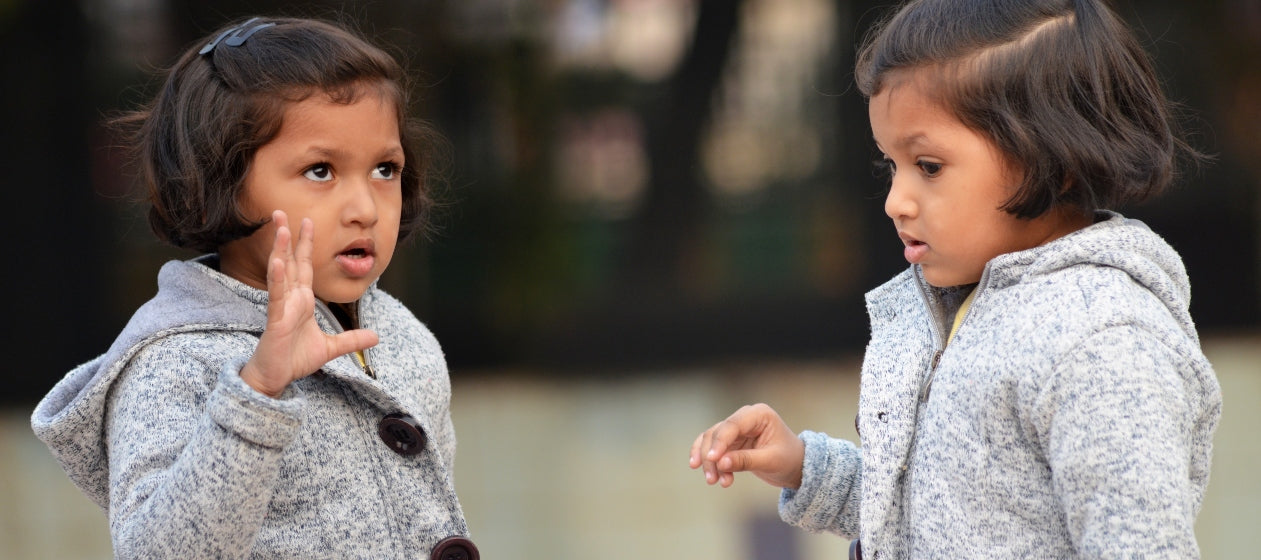
Positive Self-Talk for Kids
Showing your little one how to love themself sets them up for success. We explore positive self-talk for kids with activities you can do with your child.
Loving yourself takes work. Negative inner dialogue can be counterproductive but it’s a hard habit to break unless you start young. Through positive self-talk exercises, you can show your little one how to love themself to build a positive foundation for their social-emotional development.
We’ve also got a cute and cuddly smart companion named Snorble® that is designed to provide your kiddo with social-emotional support, build healthy habits, and prepare them for school - more on Snorble later on.
What is self-talk?
Also known as intrapersonal conversation, self-talk is any conversation we have with ourselves. For little ones, this takes practice since they’re in the process of not only learning who they are but also how the world around them works.
Our brains are wired to focus on the negative. This is a survival mechanism that was developed by our ancestors - our way, way, way, way, back ancestors aka early humans - to keep themselves safe. At the time, this was necessary since the threat of danger was always around the corner. You never knew where saber-toothed tigers were lying in wait or if the family two caves over were planning to raid your stash of pinecones.
As we evolved, our brains were still wired by this negativity bias. We can accept criticism easily but compliments? Forget it. We’d rather crawl into a cave filled with pine cones instead of accepting nice things people say about us. We may have pioneered space exploration, and invented life-saving vaccines and the pumpkin spice latte, but give us a compliment and we turn beet red.
Our children aren’t immune to negativity bias but we can shift the way they feel about themselves through positive self-talk. Additionally, self-talk is part of their social-emotional development.
The underlying societal problem
Before we get into how you can promote positive self-talk to your child, we need to explore the messages society is sending us. If you’re a BIPOC (Black, Indigenous, peope of color), differently abled, a woman, or a member of another marginalized group, the messaging directed towards you isn’t always positive. People who get “othered” by society are often treated as less than. Children must learn not to absorb and internalize the negative messages society is sending them. You may even still hang on to negative messaging you heard in your youth or conversely, may be guilty of sending these messages to others when you were in your youth. Either way, it’s essential that you let go of your own biases or the biases that were pushed upon you before you teach your little one how to positively talk to themselves.
Self-talk activities for children
When your little one can’t speak positively about themselves, it can lead to less motivation, declined cognitive functions, an inability to pay attention, and depression. However, you can provide the foundation for your kiddo to love themselves.
Here’s how:
Turn the negative into positive
Negative thoughts are going to happen whether we’re well-adjusted or not. It’s how we deal with them that determines our strengths. Talk to your little one about negative thoughts and what to do when they rear their ugly heads. It’s impossible to ignore negative thoughts so you might as well unpack them. In doing so, your child will learn where these thoughts come from and how to overcome them.
Correlated activity: Trash It, Twist It, Take It
For this game, you’ll need a pen and paper or any writing surface. Divide the paper into three columns: Trash, Twist, and Take. In the Trash column list 3-5 negative thoughts your child has experienced.
Let’s say these are the negative thoughts:
- My nose is too big
- I didn’t catch the ball during a little league game and we lost the game. Therefore, I suck at baseball
- Someone made fun of my skin color so I must be dirty
- I didn’t share my toys with my friend so I must be a “meanie”
In the Twist column, unpack each thought until it becomes a positive thought your little one can take with them.
For example:
- “My nose is too big” can be spun into something about how your child’s nose is special since everyone in the family has the same one making it a precious family heirloom.
- Not catching the ball during a game happens to everyone, even the top players in Major League Baseball. Show your child that even though they lost the game, they were able to play a team sport and have fun.
- Anyone who calls someone else dirty because of their skin color needs to reflect on why (as aforementioned above with the underlying social problem). As for your kiddo, remind them that their skin is beautiful and they should be proud of it. Impress upon them that the person who hurled insults at them is in the wrong, not them.
- “I didn’t share my toys with my friend so I must be a ‘meanie’”, can be unpacked by asking your youngster why they didn’t share their toys and how it made them feel to be called a “meanie”.
Finally, in the Take column, rewrite each negative statement in a positive way.
- My nose is too big = My nose is just the right size and I love it because it helps me breathe
- I didn’t catch the ball during a little league game and we lost the game. Therefore, I suck at baseball = I had so much fun playing baseball the other day and even though I didn’t make that catch I still played well
- Someone made fun of my skin color so I must be dirty = I am beautiful, my skin is beautiful, and I love my skin color
- “I didn’t share my toys with my friend so I must be a ‘meanie’” = I learned that when I don’t share my toys, I hurt my friend. But, I’m not a “meanie” because I will share my toys in the future
You’ve turned negatives into positives by unpacking negative thoughts and twisting them into positives that your kiddo can take with them.
Promote positivity at home
You are your child’s role model whether you know it or not. Children look up to their parents, siblings, teachers, and caregivers because these are the people who are supposed to make a positive impact on their lives. By promoting self-talk at home, your kiddo will follow suit.
Correlated activity: Hungry, Hungry, Help me
When sitting down to a family meal or any time you’re all together, have everyone go around the table and talk about a challenge they faced or are facing. In turn, each family member can say something encouraging about the person and how they handled the challenge or how they will handle the challenge. After everyone’s gone around the table, repeat back the encouragement but frame it in the first person.
For example:
An older sibling talks about a challenge with another kid at school. Everyone around the table offers something positive and encouraging. Older sibling takes everything said and spins it to:
“I am a kind person and if the other kid doesn’t see it then that’s on them.”
It’s easy to talk about what went wrong but with positive self-talk, your little one will see that they are doing their best and can recognize what went well. Plus, you’re creating a safe space where your little one can feel comfortable coming to you for support whether they need a pick-me-up or want to show how well they’re doing. We need support for the positive too!
Normalize affirmations
For children, affirmations are a great tool that they can carry with them throughout their lives. Affirmations allow your little one to engage in positive self-talk because they are actively affirming nice things about themselves. This doesn’t mean that your youngster needs to walk around saying, “I’m good enough. I’m smart enough, and gosh darn it, people like me” but they can have a little mantra they recite when they wake up or before bed.
Correlated activity: Affirmation Station
Every mirror in your home is a station on the Affirmation Railroad. Chug along with your kiddo and stop in front of each station (mirror). In front of the mirror, have your child say one nice thing about themselves that celebrates their strengths. Then, chug over to the next station. You can even name the stations after things your child likes. If you don’t have many mirrors in your home, you can choose anything as a station like a table or couch.
When saying affirmations in front of each station use the present tense to ground your little one in the moment. Avoid “mights”, “shoulds”, or “coulds” to enforce that your child is strong. Also, frame the affirmations positively by saying, “I am strong” instead of “I am not weak.”
Hand gesture toward positive self-talk
Sometimes hand gestures can say more than words ever can. When someone points at you without context, you may think that they’re mad at you or you’ve done something wrong. Whereas a gesture like a wave can signify that someone is happy to see you. For little ones still learning what each gesture means, give them a push in a positive direction. Learning the meaning of hand gestures is also part of their development which is why most babies will learn to wave between eight and 12 months.
Moreover, hand gestures combine three distinct developmental skills. Using the example of a baby waving:
- Cognitive - babies see adults wave at them and learn that it’s a greeting
- Gross motor - babies learn how to rotate their wrists and move their arms up and down in an intentional and coordinated manner
- Social communication - waving teaches babies that there’s a social component of communication because when they wave or are waved at they will reciprocate the gesture
Correlated activity: Simon Says (the remix)
Instead of playing a traditional version of Simon Says, remix it. For all positive hand gestures like waving, or patting your heart say, “Simon says” before it. For all negative hand gestures like pointing furiously or waving your index finger back and forth, don’t say “Simon says”. This will help your youngster see the difference between positive and negative gestures and learn not to internalize the negative ones. The end goal is for your child to realize that if someone throws a negative hand gesture in their direction, they don’t need to internalize its meaning and talk down to themselves in the process.
Snorble talks the (positive) talk
When we created our interactive and portable smart companion, our goal was for children everywhere to excel. With a Magical Bedtime Experience® designed to help your child fall asleep and stay asleep, healthy habit building activities, and fun educational games, no developmental stone is left unturned - even laughter because Snorble tells jokes that’ll have your youngster LOLing up a storm. Moreover, when it comes to positive self-talk, Snorble offers relaxation and reflection activities that allow your little one to take a moment to breathe and see how awesome they are.
Sources:
- Centervention
- NAEYC
- Morningside Center
- VeryWellFamily
- The Pathway 2 Success
- Counselor Chelsey
- Parenting for Brain
Photo by AMIT RANJAN on Unsplash

Positive Self-Talk for Kids
Showing your little one how to love themself sets them up for success. We explore positive self-talk for kids with activities you can do with your child.
PreviewLoving yourself takes work. Negative inner dialogue can be counterproductive but it’s a hard habit to break unless you start young. Through positive self-talk exercises, you can show your little one how to love themself to build a positive foundation for their social-emotional development.
We’ve also got a cute and cuddly smart companion named Snorble® that is designed to provide your kiddo with social-emotional support, build healthy habits, and prepare them for school - more on Snorble later on.
What is self-talk?
Also known as intrapersonal conversation, self-talk is any conversation we have with ourselves. For little ones, this takes practice since they’re in the process of not only learning who they are but also how the world around them works.
Our brains are wired to focus on the negative. This is a survival mechanism that was developed by our ancestors - our way, way, way, way, back ancestors aka early humans - to keep themselves safe. At the time, this was necessary since the threat of danger was always around the corner. You never knew where saber-toothed tigers were lying in wait or if the family two caves over were planning to raid your stash of pinecones.
As we evolved, our brains were still wired by this negativity bias. We can accept criticism easily but compliments? Forget it. We’d rather crawl into a cave filled with pine cones instead of accepting nice things people say about us. We may have pioneered space exploration, and invented life-saving vaccines and the pumpkin spice latte, but give us a compliment and we turn beet red.
Our children aren’t immune to negativity bias but we can shift the way they feel about themselves through positive self-talk. Additionally, self-talk is part of their social-emotional development.
The underlying societal problem
Before we get into how you can promote positive self-talk to your child, we need to explore the messages society is sending us. If you’re a BIPOC (Black, Indigenous, peope of color), differently abled, a woman, or a member of another marginalized group, the messaging directed towards you isn’t always positive. People who get “othered” by society are often treated as less than. Children must learn not to absorb and internalize the negative messages society is sending them. You may even still hang on to negative messaging you heard in your youth or conversely, may be guilty of sending these messages to others when you were in your youth. Either way, it’s essential that you let go of your own biases or the biases that were pushed upon you before you teach your little one how to positively talk to themselves.
Self-talk activities for children
When your little one can’t speak positively about themselves, it can lead to less motivation, declined cognitive functions, an inability to pay attention, and depression. However, you can provide the foundation for your kiddo to love themselves.
Here’s how:
Turn the negative into positive
Negative thoughts are going to happen whether we’re well-adjusted or not. It’s how we deal with them that determines our strengths. Talk to your little one about negative thoughts and what to do when they rear their ugly heads. It’s impossible to ignore negative thoughts so you might as well unpack them. In doing so, your child will learn where these thoughts come from and how to overcome them.
Correlated activity: Trash It, Twist It, Take It
For this game, you’ll need a pen and paper or any writing surface. Divide the paper into three columns: Trash, Twist, and Take. In the Trash column list 3-5 negative thoughts your child has experienced.
Let’s say these are the negative thoughts:
- My nose is too big
- I didn’t catch the ball during a little league game and we lost the game. Therefore, I suck at baseball
- Someone made fun of my skin color so I must be dirty
- I didn’t share my toys with my friend so I must be a “meanie”
In the Twist column, unpack each thought until it becomes a positive thought your little one can take with them.
For example:
- “My nose is too big” can be spun into something about how your child’s nose is special since everyone in the family has the same one making it a precious family heirloom.
- Not catching the ball during a game happens to everyone, even the top players in Major League Baseball. Show your child that even though they lost the game, they were able to play a team sport and have fun.
- Anyone who calls someone else dirty because of their skin color needs to reflect on why (as aforementioned above with the underlying social problem). As for your kiddo, remind them that their skin is beautiful and they should be proud of it. Impress upon them that the person who hurled insults at them is in the wrong, not them.
- “I didn’t share my toys with my friend so I must be a ‘meanie’”, can be unpacked by asking your youngster why they didn’t share their toys and how it made them feel to be called a “meanie”.
Finally, in the Take column, rewrite each negative statement in a positive way.
- My nose is too big = My nose is just the right size and I love it because it helps me breathe
- I didn’t catch the ball during a little league game and we lost the game. Therefore, I suck at baseball = I had so much fun playing baseball the other day and even though I didn’t make that catch I still played well
- Someone made fun of my skin color so I must be dirty = I am beautiful, my skin is beautiful, and I love my skin color
- “I didn’t share my toys with my friend so I must be a ‘meanie’” = I learned that when I don’t share my toys, I hurt my friend. But, I’m not a “meanie” because I will share my toys in the future
You’ve turned negatives into positives by unpacking negative thoughts and twisting them into positives that your kiddo can take with them.
Promote positivity at home
You are your child’s role model whether you know it or not. Children look up to their parents, siblings, teachers, and caregivers because these are the people who are supposed to make a positive impact on their lives. By promoting self-talk at home, your kiddo will follow suit.
Correlated activity: Hungry, Hungry, Help me
When sitting down to a family meal or any time you’re all together, have everyone go around the table and talk about a challenge they faced or are facing. In turn, each family member can say something encouraging about the person and how they handled the challenge or how they will handle the challenge. After everyone’s gone around the table, repeat back the encouragement but frame it in the first person.
For example:
An older sibling talks about a challenge with another kid at school. Everyone around the table offers something positive and encouraging. Older sibling takes everything said and spins it to:
“I am a kind person and if the other kid doesn’t see it then that’s on them.”
It’s easy to talk about what went wrong but with positive self-talk, your little one will see that they are doing their best and can recognize what went well. Plus, you’re creating a safe space where your little one can feel comfortable coming to you for support whether they need a pick-me-up or want to show how well they’re doing. We need support for the positive too!
Normalize affirmations
For children, affirmations are a great tool that they can carry with them throughout their lives. Affirmations allow your little one to engage in positive self-talk because they are actively affirming nice things about themselves. This doesn’t mean that your youngster needs to walk around saying, “I’m good enough. I’m smart enough, and gosh darn it, people like me” but they can have a little mantra they recite when they wake up or before bed.
Correlated activity: Affirmation Station
Every mirror in your home is a station on the Affirmation Railroad. Chug along with your kiddo and stop in front of each station (mirror). In front of the mirror, have your child say one nice thing about themselves that celebrates their strengths. Then, chug over to the next station. You can even name the stations after things your child likes. If you don’t have many mirrors in your home, you can choose anything as a station like a table or couch.
When saying affirmations in front of each station use the present tense to ground your little one in the moment. Avoid “mights”, “shoulds”, or “coulds” to enforce that your child is strong. Also, frame the affirmations positively by saying, “I am strong” instead of “I am not weak.”
Hand gesture toward positive self-talk
Sometimes hand gestures can say more than words ever can. When someone points at you without context, you may think that they’re mad at you or you’ve done something wrong. Whereas a gesture like a wave can signify that someone is happy to see you. For little ones still learning what each gesture means, give them a push in a positive direction. Learning the meaning of hand gestures is also part of their development which is why most babies will learn to wave between eight and 12 months.
Moreover, hand gestures combine three distinct developmental skills. Using the example of a baby waving:
- Cognitive - babies see adults wave at them and learn that it’s a greeting
- Gross motor - babies learn how to rotate their wrists and move their arms up and down in an intentional and coordinated manner
- Social communication - waving teaches babies that there’s a social component of communication because when they wave or are waved at they will reciprocate the gesture
Correlated activity: Simon Says (the remix)
Instead of playing a traditional version of Simon Says, remix it. For all positive hand gestures like waving, or patting your heart say, “Simon says” before it. For all negative hand gestures like pointing furiously or waving your index finger back and forth, don’t say “Simon says”. This will help your youngster see the difference between positive and negative gestures and learn not to internalize the negative ones. The end goal is for your child to realize that if someone throws a negative hand gesture in their direction, they don’t need to internalize its meaning and talk down to themselves in the process.
Snorble talks the (positive) talk
When we created our interactive and portable smart companion, our goal was for children everywhere to excel. With a Magical Bedtime Experience® designed to help your child fall asleep and stay asleep, healthy habit building activities, and fun educational games, no developmental stone is left unturned - even laughter because Snorble tells jokes that’ll have your youngster LOLing up a storm. Moreover, when it comes to positive self-talk, Snorble offers relaxation and reflection activities that allow your little one to take a moment to breathe and see how awesome they are.
Sources:
- Centervention
- NAEYC
- Morningside Center
- VeryWellFamily
- The Pathway 2 Success
- Counselor Chelsey
- Parenting for Brain
Photo by AMIT RANJAN on Unsplash
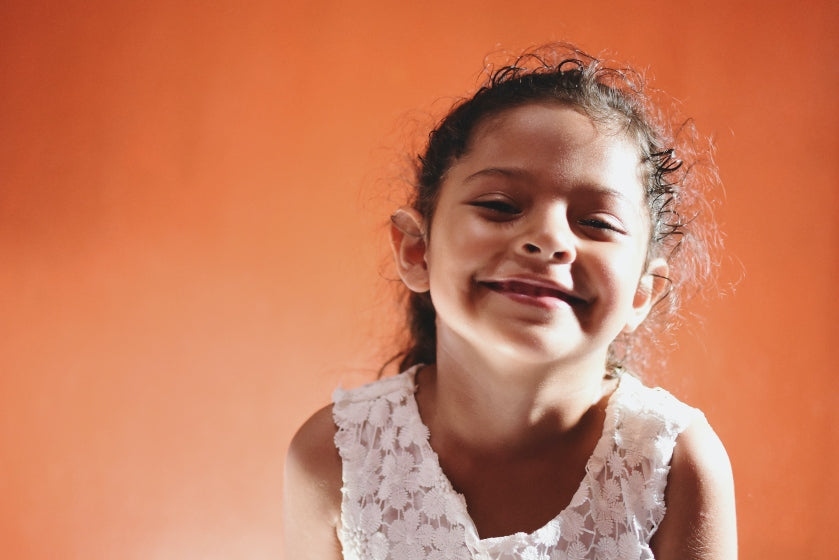
How to Teach Emotional Expression to Kids
Can you teach your little one emotional expression? Yes, and you can even make it fun!
PreviewUse your words. How many times have you said that to your kiddo? For children, expressing their emotions doesn’t come easily. You can teach emotional expression to your little one and explain the difference between emotions and feelings. You can also lean on Snorble®, our smart companion for children designed to teach healthy habits and social-emotional learning through educational interactive games. More on Snorble later but first, children need to learn what emotions are before they can express themselves with words.
What’s the difference between emotions and feelings?
Feelings and emotions are not synonyms, nor are they interchangeable. Although they do share similarities there is an integral difference between the two: feelings are experienced consciously whereas emotions can be manifested consciously or subconsciously.
Feelings encompass both physical sensations and emotional experiences. Think of hunger or pain. Both are conscious experiences that we know are happening to us. When we’re hungry we know it even if our stomach doesn’t grumble. When we’re in pain, we know it because, well, it hurts. With these feelings come emotions. Are we hungry because we’re bored? Does pain bring sadness and angst because we stubbed our toe?
For children, it can be confusing to understand the difference between physical pain and sadness until they can put a name to their emotions.
How can you teach emotional expression to your child?
When showing your child how to use their emotions, you’re giving them permission to feel by labeling their emotions. Once kiddos learn that it’s okay to feel whatever they’re feeling, they’ll have an easier time expressing how they feel.
To teach your little one about emotional expression you can:
Use feeling words
Feeling words go beyond common emotions like sadness, happiness, and anger. These are words that children can use every day to express how they feel that can pinpoint their exact emotions.
Feeling words can be split into positive and negative categories. Keep in mind that negative doesn’t mean bad. Negative feelings are just as valid as positive ones and it’s important that your kiddo learns that.
Positive:
- Brave
- Cheerful
- Curious
- Excited
- Fantastic
- Friendly
- Generous
- Important
- Interested
- Surprised
- Proud
- Silly
- Shy
- Satisfied
- Safe
- Relieved
- Peaceful
- Loving
- Calm
Negative:
- Confused
- Disappointed
- Embarrassed
- Ignored
- Impatient
- Jealous
- Lonely
- Bored
- Frustrated
- Uncomfortable
- Worried
- Stubborn
- Overwhelmed
- Tense
Whether the word your child uses falls into the negative or positive category, the fact that they’re able to use feeling words to express themselves is a huge step in the right direction. When kids can get a handle on their emotions by using feeling words you’ve given them the tools they need to speak up for themselves in other situations.
Sing it out
Songs like “If You’re Happy and You Know it” show kids that emotions can be fun. You don’t have to use real lyrics and tunes. Making up new lyrics to “Row Your Boat”, “Ring Around the Rosie” or creating your own melody to show your child the benefits of expressing their emotions can be a fun activity. You don’t have to have pipes like Celine Dion either. Belting out tunes and having a blast while learning is a gift you can give your kiddo. And who knows, you could unlock their or your hidden singing talents.
Press pause on the story
When reading to your child, take a moment to press pause on the story and ask questions like, “How do you think this character is feeling?” or “How would you react to this situation? Would you be scared too?”. You can also have your child guess how the characters are feeling and have them think of a time when they felt those same emotions.
Face your faces and bodies
When kids can identify the emotions portrayed physically by others (smiles, frowns, balled fists, smirks, hands on hips, etc.), they’ll have a better chance of expressing their own emotions. Body language and facial expressions tell us when someone is angry, happy, surprised, and pretty much every other emotion out there. Showing your child how to recognize when you and the people around them are expressing emotions via body and face, they’ll learn to react accordingly and pay attention to their own outward expressions.
Explain behaviors vs emotions
Feeling angry is one thing but throwing a toy across the room is another. If your kiddo is overwhelmed by their emotions, especially when they’re upset, they may not be able to see that their behavior has shifted. All feelings and emotions are valid. However, all behaviors aren’t. Explain to your little one that being angry is perfectly normal and acceptable but acting aggressively to match their anger isn’t. Plus, when your youngster learns to manage their behaviors while still expressing their emotions, they’re making progress in their social-emotional development.
Snorble’s got all the feels
Our smart companion, Snorble, was created with children’s development in mind. Based on an e-pedagogical educational method that allows kids to excel through play-based learning, Snorble encourages children to adopt healthy habits and social-emotional learning techniques, and get a good night’s sleep. Between the Magical Bedtime Experience™, storytime, games, and jokes, your little one will have everything they need to shine. Well, they already shine, but Snorble’ll help them shine even brighter!
Sources:
- Georgetown University Center for Child and Human Development
- Proud to Be Primary: Emotions for Kids
- Hi Mama: Teaching Emotions to Young Children
- Vanderbilt University: Teaching Your Child to Identify and Express Emotions
- Kiddie Matters: Ways to Teach Children about Feelings
- Wake Forest University: Difference Between Emotions and Feelings
Photo by Jorge Franco on Unsplash

Black History Month: 5 More People Who’ve Made an Impact
For Black History Month, we celebrate these icons and hope children everywhere can learn about how they've changed the world and find new heroes to look up to.
PreviewBlack History Month is in full swing and instead of highlighting the usual amazing people who’ve made a difference in our world - we love you, Sojourner Truth! - we’ve decided to look at those who’ve made a difference in the 20th and 21st centuries.
Whether you’re a member of the Black community or not, the following people should be an inspiration for kiddos everywhere. You can read the first part of this post here.
Serena Williams: Athlete, Icon
Serena Williams is the G.O.A.T. Do we need to say more about one of the most accomplished tennis players of all time? Probably not, but we will. Besides making tennis more inclusive and changing how we look at athletic women’s bodies - strong is beautiful! - Williams is an inspiration for Black children who are now picking up rackets to emulate their idol. The best part: she’s not done. Williams is starting her second act as an entrepreneur and investor and we can’t wait to see what she does next since retiring from the court. She’s also a great Instagram follow where she gives us a peek into her life with her husband and adorable daughter.
Bad Brains: Musicians, Punk Rock Royalty
Rock music is often hidden behind a gate. This gatekeeping can discourage people from picking up an instrument or rocking out. For white artists, thrashing around on stage while making a political point is seen as brave. For Black artists, it’s barely even seen. Except for Bad Brains. This Washington D.C. band started as a jazz fusion ensemble until they learned the power of punk in the mid-70s. Since becoming pioneers in the east coast punk scene, Bad Brains have released nine full-length albums, four EPs, four live recordings, and a slew of demos, compilations, and singles. And as the kids today say, their music definitely slaps.
Katherine Johnson: Mathematician, STEM pioneer
STEM is cool. Learning about cause and effect is also cool. What’s even cooler? Knowing your exact calculations of orbital mechanics put a man on the moon. Katherine Johnson is proof that math can be exciting and fun, and you can make a successful career out of it. This mathematician was one of the first African-American women to work as a NASA scientist and spent her illustrious career calculating everything and anything to ensure that space was no longer the final frontier but a place to gather important data. If the name sounds familiar it’s because Johnson was played by Taraji P. Henson - another G.O.A.T. - in the film Hidden Figures. She’s also part of Barbie’s Inspiring Women™ Series and we have a feeling she would’ve loved our interactive smart companion for children, Snorble.
Cori Bush: Congresswoman, Nurse, Activist
A member of The Squad - an elite group of congresspeople fighting daily for the rights of minorities across the United States - Cori Bush is the real deal. She’s a registered nurse, community activist, and organizer, ordained pastor, and was once so destitute she lived in a van with her children. She not only persevered and became a congresswoman for Missouri’s first district, but Cori also sits on the House Judiciary Committee and the House Oversight Committee, and is the Vice Chair of the Subcommittee on Crime, Terrorism, and Homeland Security. To say she’s busy is an understatement.
James Baldwin: Writer, Activist
Reading and writing are fundamental parts of any child’s development and James Baldwin helped a generation of Black children everywhere aspire to put pen to paper - or more aptly, put fingers to keyboard. His novels, essays, plays, and poems gave a voice to the voiceless in a time when being queer was regarded as evil. From Go Tell it On the Mountain to If Beale Street Could Talk, Baldwin’s electrifying works show the power of literature and how speaking the truth can produce generations of free thinkers.
Honorable mentions:
- Tarana Burke - founder of the #MeToo Movement
- KRS-One - he basically invented politically-driven hip hop
- Nicole Hannah-Jones - journalist who developed The 1619 Project
- Maia Chaka - the first Black woman to officiate an NFL game
Photo by Lawrence Crayton on Unsplash

Black History Month: 5 People Who’ve Made an Impact
For Black History Month, we're celebrating those who've made an impact and continue to build for a better future for all.
PreviewToday marks the first day of Black History Month. Instead of highlighting the usual amazing people who’ve made a difference in our world - we love you, Harriet Tubman! - we’ve decided to look at those who’ve made an impact on the 20th and 21st centuries.
Whether you’re a member of the Black community or not, the following people should be an inspiration for your kiddo.
Jean-Michel Basquiat: Artist
Although he passed away in 1988 at the age of 27, Jean-Michel Basquiat’s contributions to the art world remain a major influence on young artists to this day. The Brooklyn-born Basquiat - say that five times fast! - took his everyday experiences and turned them into brilliant works of art. Whenever he touched a canvas, Basquiat was able to create a meaningful expression that made the art world gasp in awe. He also collaborated with Andy Warhol while inspiring a generation of Black kids to pick up a paintbrush, spray can, and other media to become artists themselves.
Quinta Brunson: Writer, Producer, Actress, Comedian
Abbott Elementary is one of the best shows around. Told from the perspective of the teachers at an underfunded public school in Philadelphia, the show is the brainchild of Quinta Brunson, a former BuzzFeed producer. Brunson stars in, produces, and writes the show along with a cast of the funniest performers and legends - we see you, Sheryl Lee Ralph! Brunson has won multiple awards for the show, including an Emmy. Our hope is that Abbott Elementary does an episode about our interactive smart companion for children, Snorble®. But, until then, we hope everyone everywhere can be inspired as we are by each episode of Abbott.
Chadwick Boseman: Wakanda’s Forever King
Children need superheroes that look like them because representation matters. When Chadwick Boseman was cast as the titular T’Challa in Black Panther, Black children everywhere had someone that looked like them saving the world from evil. Boseman wasn’t the first Black Marvel movie superhero - Anthony Mackie kicked things off with his portrayal as The Falcon - but it was Black Panther that really made the industry take notice. Even the most critical comic book fans were enamored with Boseman’s portrayal of T’Challa and those people are never happy with casting choices. Unfortunately, Boseman’s life was cut short by cancer in 2020 but his legacy and compassion live on.
Laverne Cox: Actress, Producer, Activist
We don’t like to throw around the word “trailblazer” lightly unless someone is an actual trailblazer like Laverne Cox. Besides being the first transgender person to be nominated for an Emmy, Cox has led the way for transpeople to be themselves without scrutiny - kind of, we still have a long way to go to ensure the LGBTQ+ community enjoys the same rights as others. But children everywhere can look up to Cox and see how one person’s advocacy can change the world.
Viola Desmond: Activist, Icon
Canada may not be on your radar when it comes to civil rights icons, but Viola Desmond is not only an icon, she was a businesswoman and the first Canadian woman to be featured alone on a unit of currency (the $10 bill). In 1946, Desmond challenged racial segregation at a theater in Nova Scotia by refusing to leave the whites-only area. Her ordeal became one of the most publicized racial discrimination cases in Canada and paved the way for the country’s civil rights movement. In 2018, the government named her a National Historic Person which is pretty much like being knighted.
Honorable mentions:
- Stylist to the stars, Law Roach - he’s the reason Zendaya looks so phenomenal on red carpets
- Solange - yes, she’s Beyoncé’s sister but she’s also got a set of pipes on her
- Garrett Morris - original SNL cast member who had everyone in stitches on a recurring Weekend Update segment as a translator
- Willie O’Ree - first Black NHL player
We’ll be posting more later this month so stay tuned for more people who’ve made an impact!
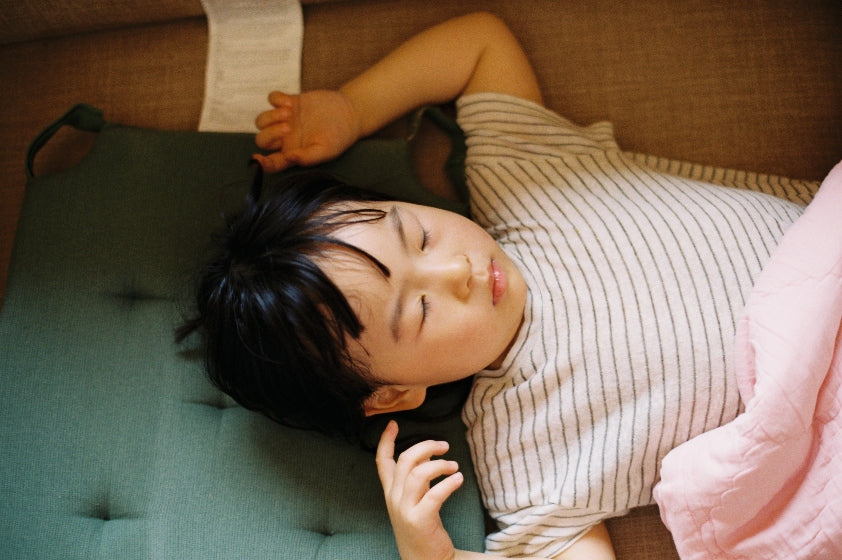
Is Melatonin Safe for Children?
Is melatonin safe for kids? We dive deep into this sleep aid to see what the side effects are, how it works, and if you can give it to your kiddo.
Preview“Why won’t my little one fall asleep?,” you ask yourself, exasperated from going back and forth to their bedroom repeatedly throughout the night. There are many over-the-counter sleep remedies available and the one that seems to generate the biggest buzz is melatonin.
Is melatonin safe for kids? Before we get there, what exactly is melatonin and what does it do? And are there sleep aids for kiddos that don’t require them to ingest a pill or liquid? Here’s a hint: yes, and one of those alternatives is our smart companion, Snorble® - more on that later.
What is melatonin?
There are two types of melatonin:
- The natural hormone our bodies make
- The lab-created version you buy in stores
The hormone: What is the natural version of melatonin?
Melatonin is a hormone naturally produced in our bodies that correlates to the time of day. When it’s dark, our brain tells the body to release melatonin to signal that it’s time to think about going to bed. In the morning and throughout the day (when it’s light out), our brain decreases melatonin production which is why we don’t get sleepy during the day - unless we’re overtired.
As we get older, melatonin production declines, making it harder for us to fall asleep. Although this doesn’t happen to everyone and with a good bedtime routine in place, we can still convince our brains that bedtime equals sleep time. The same goes for children. With a bedtime routine, your kiddo will be set up with great sleeping habits that they can carry with them throughout their life.
The lab-created supplement: Is melatonin a drug?
The melatonin you can purchase is made in a lab and available as a tablet, capsule, or syrup. In Europe, Japan, and Australia, melatonin is only available with a prescription. In North America, it is available over the counter and anyone can purchase it at their local pharmacy and big box drugstores. The FDA considers melatonin to be a dietary supplement because it occurs naturally in some foods like tart cherry juice and walnuts. (These does not mean that consuming tart cherry juice or walnuts will make your little one fall asleep faster.)
How does melatonin work?
Melatonin is produced by the pineal gland in our brains. This hormone is both a chronobiotic agent (aka helps our brains tell what time of day it is) and a hypnotic. This means that the chronobiotic properties regulate our body’s internal clock and the hypnotic properties are what help us fall asleep because the chronobiotic effect occurs in all of us without prompting. Around 1-3 hours before the onset of sleep, our brain goes into dim light melatonin onset (DLMO) telling our bodies that it’s time to start getting into relaxation mode.
When we take melatonin supplements, we are using them for their hypnotic effects. Since we are taking a higher dose than what’s naturally occurring in our bodies, the supplements are signaling to our brains that it’s time to sleep within 30 minutes to an hour of ingestion.
What are the side effects of melatonin?
When taken orally and in appropriate dosage, melatonin is generally safe. However, there are some side effects:
- Headache
- Nausea
- Drowsiness
- Dizziness
Taking melatonin supplements nightly could delay the onset of puberty and hinder hormonal development. Because the body produces melatonin on its own, when adding more melatonin regularly to induce sleep, our brains may be confused and overproduce other hormones to create a balance.
Can you give melatonin to a child?
Yes, melatonin is safe for children but, before giving your child melatonin, please consult your pediatrician. We cannot stress the importance enough of talking to a medical professional before administering melatonin to your kiddo.
What about children with sleep disorders? Can they use melatonin?
Sleep problems in children, especially toddlers, can affect their behavior and cognitive functioning. If these problems aren’t addressed early they can affect your child’s future quality of life. Sleep disorders in children can be caused by other underlying issues such as asthma, atopic dermatitis, attention-deficit hyperactivity disorder (ADHD), autism spectrum disorder (ASD), and nyctophobia-induced anxiety (fear of the dark). Melatonin may allow kiddos with sleep disorders to catch some much-needed zzzs but please, consult a doctor before giving your little one any.
Snorble’s ready for bed
Instead of reaching for that jar of melatonin to help your little one sleep, reach for Snorble! Our smart companion for children is designed to give your kiddo the emotional, learning, and cognitive tools necessary to fall asleep and stay asleep. The Magical Bedtime Experience™ is complete with pajama time, tooth brushing prompts, storytime, and other important aspects of bedtime to give your child a one-way ticket to dreamland. Besides giving your kiddo everything they need to get to bed, Snorble’s interactive daytime games are education-based to prepare your child for school, teach healthy habits, and encourage social-emotional growth. There are also winddown activities for relaxation like yoga and reflection, and jokes for when your little one needs a good laugh.
Sources:
- Mayo Clinic melatonin overview
- Craig Canapari, MD
- NIH circadian rhythm overview
- NIH melatonin overview
- McGill University: How melatonin can be sold without a prescription
Photo by zhenzhong liu on Unsplash
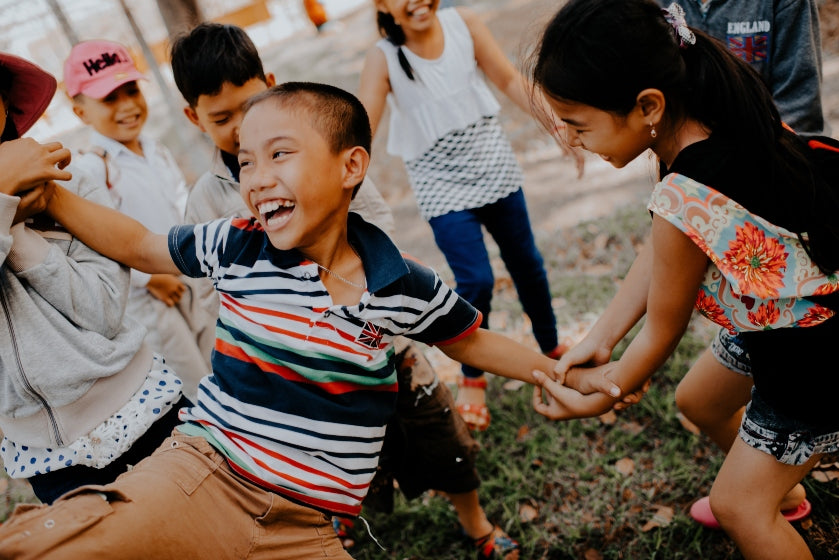
Let’s Get Physical: The Benefits of Exercise for Children
How do you get your kiddo moving? We explore the benefits of physical activity for children and how you can get your little one the right amount of exercise.
PreviewAn active child is a well-adjusted child because physical activity improves their mental health, and decreases the risk of anxiety, pain, and loneliness. Moreover, developing your child’s physical skills gives them tools they can use throughout their lives like positive body image.
Getting your kiddo up on their feet can turn into an impressive feat once you teach them how important moving around every day is. How do you get your little one to [cue the music] Move it! Move it! in a way that’s fun and exciting?
We’ve got activities you and your child can do together and info on how a cute and cuddly smart companion named Snorble® can provide a little push to get your kiddo up and at ‘em.
How much exercise should children get?
The U.S. Department of Health and Human Services recommends the following:
- For toddlers (kids aged 1-2 years), they should also be active for about three hours per day. Anything from jumping, running, hopping, light energetic movements like dance, and active play are encouraged for this age group.
- Preschoolers (children aged 3-5 years) should be actively playing throughout the day. Active play includes about three hours a day of light, moderate and vigorous activities. Those three daily hours should include free play, planned play, and adult-led physical activity.
- School-aged children (6-8 year-olds) should get 60 minutes or more of moderate to vigorous physical activity daily. This age group can benefit from muscle and bone-strengthening activities like stretching and walking (at least three days a week) on top of traditional physical activities for school-agers like swimming lessons, organized sports, gymnastics, and dance classes.
Ideally, no child over three years old should be inactive for more than 1-2 hours at a time (unless they’re sleeping). But, there are long road trips to grandma’s house and other circumstances that may keep them from moving around. It happens!
Benefits of developing your child’s physical skills through activity
Bopping around, dancing, running, jumping - these are all essential aspects of your little one’s growth. Physical activity promotes:
- Brain function - Essential mental functions are supported when kiddos exercise. Kids who move have better motor skills like hand-eye coordination, may be adept at problem-solving, have stronger attention skills, and are overall better learners.
- Good health - Physical literacy is like reading: it’s fundamental to your kiddo’s growth. When we’re active, our bodies produce endorphins, a hormone that acts as a natural painkiller. When endorphin production is in full swing, we may feel less pain and experience an overall sense of calm with an improved mood. Active children have higher energy levels during the day and sleep better at night. Couple daily exercise during the day with Snorble’s Magical Bedtime Experience™ and you’ll have one well-rested kiddo on your hands. (More on that in a bit.)
- Interpersonal and intrapersonal communication - Physical activity, especially team sports, shows children how important communication is. When children play in a group setting, they learn how to communicate with their teammates and work towards a common goal of winning the game. Although winning doesn’t matter, the journey of how children work in tandem and focus on the outcome of each step in whatever game they’re playing gives them the tools needed to relieve social pressures, develop a rapport with their peers, and offer words of encouragement to their teammates and even themselves.
- Better relationship with their own body - As children get older and puberty kicks in, their bodies go through changes that they may have a hard time coping with. But, when kids are active from toddlerhood on, they can develop a great relationship with their bodies leading to improved body image, self-esteem, self-worth, and self-confidence. If you instill an appreciation for the human body and what it can do instead of how it looks, you’re helping your kiddo understand that what they weigh or how they’re built doesn’t matter as long as they’re healthy and active. Positive body image goes a long way and it’s something your little one can carry with them throughout their life.
Physical activities for little ones
You can do many exercise-related activities with your youngster like going for a walk. This is especially easy to do when you have a dog or another pet that needs to be walked because you can make this a daily ritual for you and your child. Besides you and your little one taking your pet out for bathroom duties, you can:
- Teach your kiddo to ride a bike.
- Play outside with them when the weather permits. And if the weather doesn’t permit, build an indoor fort using your couch cushions and towels.
- Games like tag teach your child endurance as they try and escape the dreaded “It!”
- If you have a park nearby, equipment like monkey bars provide strength training for your kiddo.
- For little ones, learning to bend down and tie their shoes can improve their flexibility.
- Community centers sometimes have affordable programs for children like gymnastics, dance, soccer, swimming, and basketball where it’s not about how well they play but how much they move. Plus, organized sports and activities give children a chance to interact with their peers and learn teamwork skills.
Snorble’ll get your child moving
Our smart companion is designed with children’s development in mind. When we created Snorble, our goal was to prepare children for the world they live in and equip them with the tools necessary to pick up healthy habits, develop their social-emotional skills, instill a love of learning, and get a good night’s sleep. With a customizable bedtime routine with soothing soundscapes and a nightlight that ushers in sleep, educational games, yoga and mindfulness activities, and fun tasks to get your kiddo moving around, you’ll have everything you need for their positive development.
Sources:
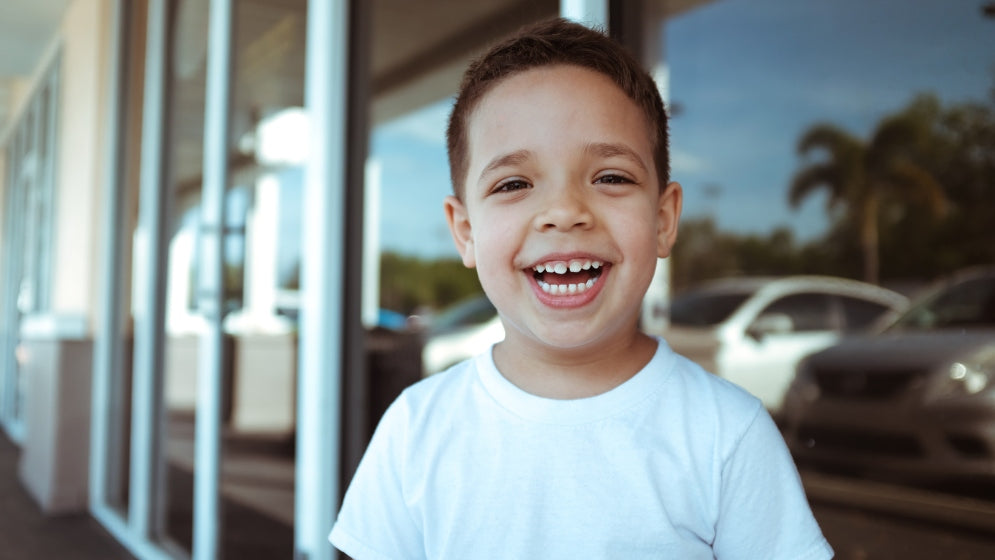
6 Easy Acts of Kindness for Children to Do
Kindness is key in today’s world. These 6 acts of kindness are simple and will show your kiddo how easy it is to be nice.
PreviewWhen children learn to be kind, they’re set up for life. Kindness can be taught and it starts with you. Showing your kiddo how to do good deeds can improve their well-being, develop positive motivations and increase their self-esteem. When kids are kind, they also get a better understanding of their own privilege, appreciate what they have, and empathize with others. Plus, when children are kind instances of violence and bullying are less likely to occur.
By showing your little one how to perform simple acts of kindness, you’re also showing them how to be compassionate, generous, and giving. We often use the word “perform” when it comes to doing good but it’s not a performance. When your child learns to be kind through various actions, they won’t be putting on a show, they’ll be proud of themselves and there’ll be nothing performative about it.
We’ve compiled a list of six kind acts that you can do with your child to show them how kindness works, and how our smart companion, Snorble®, can help create a kinder tomorrow for your kiddo (more on that in a bit).
Six acts of kindness that you can do with your kiddo
This is a loose guide and we encourage you to involve your child in the discussion of which act(s) you decide make the most sense for your family. The reason we’ve chosen these particular acts of kindness is they don’t require much except a few dollars and a little love.
Smile safely
What’s the cutest thing ever? A smiling child! By showing your kiddo how to smile safely and comfortably, you’re giving them an outlet for happiness. That’s great, you say, but where’s the act of kindness? It’s in their smile. Seeing another person smile is contagious and could make someone’s day. However, err on the side of caution when it comes to who your youngster is smiling at. You can make a “smile at” list with them and decide who in your lives could use a quick pick-me-up whether it’s a neighbor or bus driver or even a sibling who is having a bad day.
Attack with compliments
Just like a smile can make someone’s day, a compliment goes a long way. Showing your little one how to compliment people will lead to acts of kindness. By teaching your child how compliments can be beneficial to the giver and receiver, you’re also teaching them about cause and effect. For instance, give your kiddo a simple compliment and then ask them how they feel after hearing it. Then ask them to give you a compliment and explain how you feel afterward. Eventually, your little one will give compliments to their friends and family in earnest when they understand the positive effect this simple gesture can have.
Be perfectly polite
Teaching your child to say “please” is an easy act of kindness that can be done daily. When your kiddo understands how powerful these simple words are, you’ll create a monster, a monster of love and respect. Being polite is the perfect way to instill kindness in your child that won’t take much effort on your part as long as you set a good example. When your little one sees you thanking others and saying sorry when you make a mistake, they’ll follow suit.
Say thank you for services
We often take for granted the people in our lives that aren’t a part of our Village. From teachers to cashiers at your local grocery store to the crossing guard that ensures your kiddo gets across the street safely, these people make the world a better place and are often ignored. Have your child pick their favorite non-family member or friend and craft a thank you note. This little act of kindness can go a long way, especially if your kiddo can hand-deliver it.
Put carts in their place
The grocery store is a very interesting locale. People leave their carts strewn about the parking lot and entrance when they’re done with their shopping. Some people are allergic to putting items back in their place when they realize they don’t need them. How many times have you seen a random banana in the frozen food section? However, you can be the exception by showing your little one a simple act of kindness: putting your cart back in the corral when you’re done. This helps your youngster understand that kind behavior doesn’t always have to be a grand gesture. Something as simple as returning a shopping cart to its rightful place or putting items back where they belong when you don’t need them is a behavior that works at home too. Finished with that toy? Put it back where it belongs until you want to play with it again.
Give the gift of toiletries and socks
For this act of kindness, you’ll need a few plastic bags (or toiletry bags), travel-size shampoos, toothpaste, toothbrushes, bandaids and deodorants, and pairs of socks. You can pick up these items at the dollar store and you and your kiddo can make gift bags to donate to shelters in your community. In doing so, your child will learn about those less fortunate and see how their kind act of giving essential items can make a huge impact.
Invest in kindness with Snorble
Our interactive smart companion is designed to prepare children for school through play-based learning initiatives. Besides educational games, healthy habit-building exercises, and a customizable bedtime routine complete with a nightlight and soothing soundscapes, there’s also a reward system where you can gift your little one virtual stars when they complete certain tasks. Moreover, Snorble has yoga and mindfulness activities to give your youngster the tools they need to be a kind, well-rounded individual as they develop their social-emotional skills.
Sources:
- https://www.verywellfamily.com/random-acts-of-kindness-for-kids-4136440
- https://www.mindfulmazing.com/acts-of-kindness-for-kids/
- https://mcc.gse.harvard.edu/reports/children-mean-raise
- https://mcc.gse.harvard.edu/research-initiatives/caring-families-research-project
- https://www.rd.com/article/acts-of-kindness-for-kids/
Photo by Moses Vega on Unsplash
